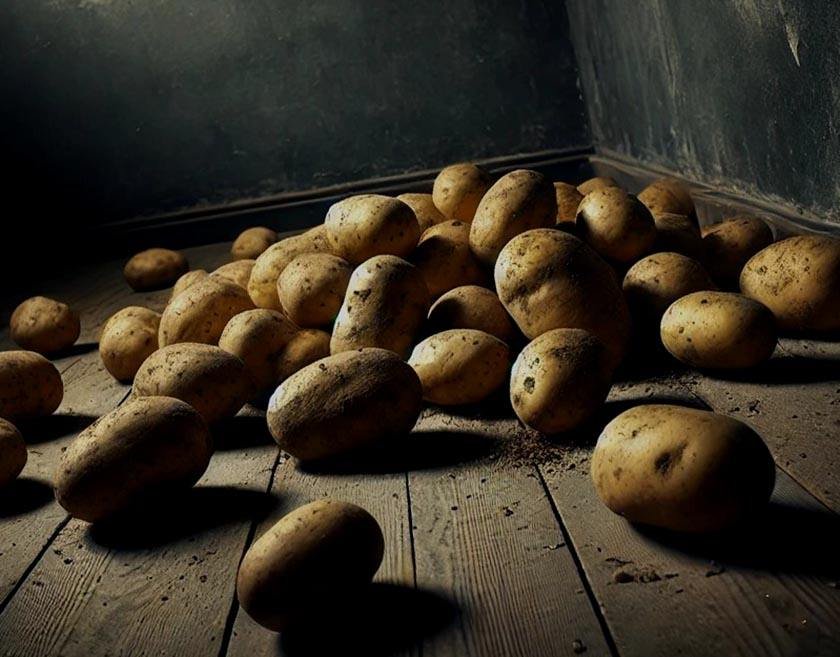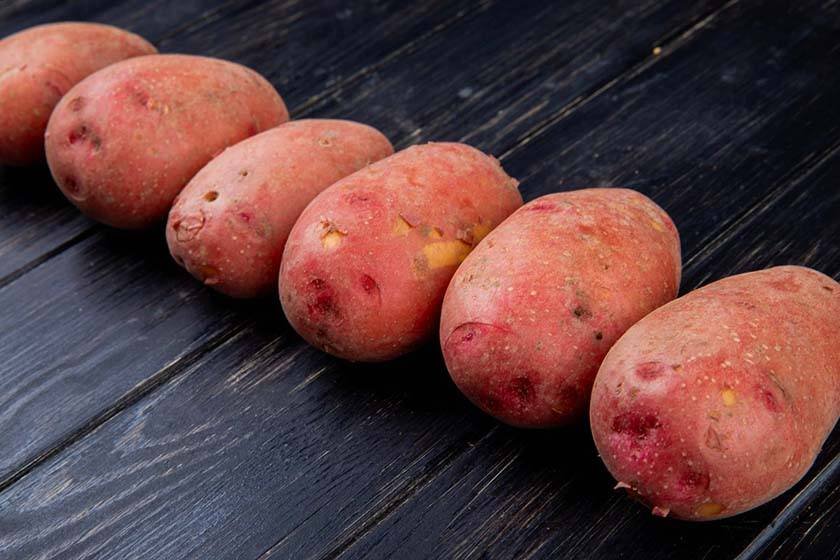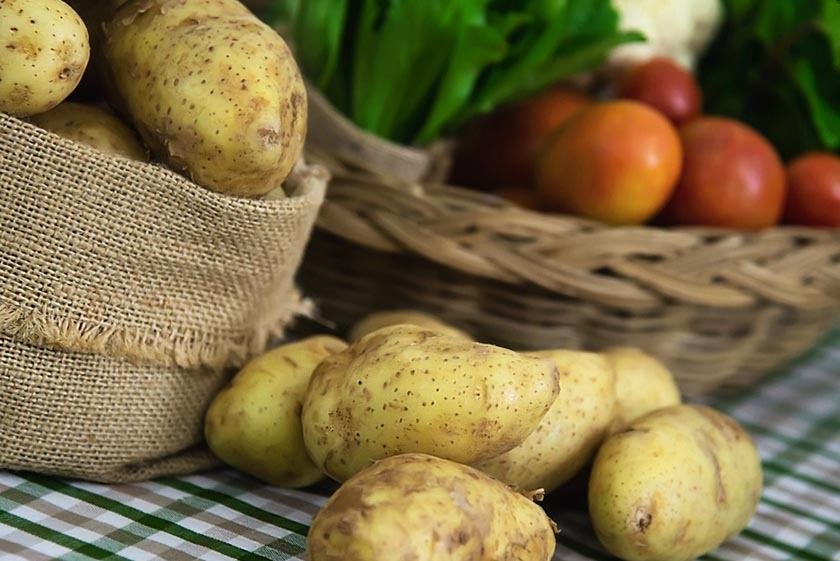Proper storage of potatoes is essential for maintaining their freshness and flavor. With numerous varieties available, it’s important to know the best way to store potatoes, as each type has its own unique storage requirements.
This guide outlines the best practices for storing potatoes, ensuring they remain delicious for as long as possible. You will learn about the optimal conditions for storage, the signs of spoilage to watch for, and effective methods to revive sprouted potatoes.
Additionally, you will discover creative ways to use up any leftovers. Prepare to enhance your expertise in potato storage.
Why is Proper Storage of Potatoes Important?
Proper storage of potatoes is essential for maintaining their freshness and preventing spoilage, which can contribute to food waste and health risks.
Understanding the ideal conditions for potato storage, such as keeping them in a cool temperature and dark places, is important to ensure that various potato varieties – including organic and conventional potatoes – retain their nutrients.
By implementing effective moisture control, pest management, and ventilation strategies, you can significantly extend the shelf life of your potatoes and ensure they remain a wholesome part of your diet.
What is the Best Way to Store Potatoes?
The most effective way to store potatoes includes creating optimal conditions by using breathable containers, maintaining a cool temperature, and ensuring a dark environment free from light exposure.
By choosing appropriate storage options such as burlap sacks, cardboard boxes, or mesh bags, you can improve airflow and humidity control, which helps prevent potato rot and sprouting.
Utilizing layering methods is the best way to store potatoes, as it can further optimize your storage space while preserving their quality, ultimately enhancing your overall food preservation efforts.
1. Store in a Cool, Dark Place
 Storing potatoes in a cool, dark place is essential for maintaining their freshness and preventing spoilage. The ideal temperature range for potato storage is between 45°F and 50°F (7°C to 10°C), which helps control moisture and prevents sprouting caused by exposure to light and heat. By selecting a suitable location, such as a root cellar or basement, you can significantly enhance the shelf life of your potatoes.
Storing potatoes in a cool, dark place is essential for maintaining their freshness and preventing spoilage. The ideal temperature range for potato storage is between 45°F and 50°F (7°C to 10°C), which helps control moisture and prevents sprouting caused by exposure to light and heat. By selecting a suitable location, such as a root cellar or basement, you can significantly enhance the shelf life of your potatoes.
These environments, characterized by consistent cool temperatures and a lack of light, create optimal conditions for potato storage. Ensuring good ventilation is crucial, as it helps manage humidity levels and further protects against decay.
In contrast, storing potatoes in warm areas or direct sunlight can lead to rapid deterioration, transforming those vibrant tubers into shriveled, unappealing products. Therefore, choosing the right storage location is pivotal in preserving the quality and extending the usability of these essential staples.
2. Avoid Exposure to Light
Avoiding exposure to light is crucial when storing potatoes, as light can trigger the production of solanine, leading to the formation of green potatoes that pose health risks.
Along with resulting in a bitter taste, consuming green potatoes can lead to symptoms such as nausea, headaches, and even more severe gastrointestinal issues. Therefore, it is essential to implement effective storage strategies.
Using opaque containers is one effective method, but placing potatoes in a cool, dark cellar can significantly reduce light exposure as well. Regularly inspecting stored potatoes for any signs of sprouting or greening is advisable. The best way to store potatoes is by maintaining a dry and well-ventilated environment, which can significantly enhance their longevity and prevent the harmful effects caused by light exposure.
By adopting these simple yet impactful practices, you can ensure the safe consumption of this staple food.
3. Keep Away from Moisture
Keeping potatoes away from moisture is crucial for effective storage, as excessive humidity can lead to rot and spoilage. Utilizing breathable containers, such as burlap sacks or mesh bags, promotes airflow, which helps control moisture levels and extend the shelf life of your potatoes. Regularly checking for softness and signs of spoilage will further ensure that your stored potatoes remain fresh and healthy.
Along with using breathable containers, it is vital to store potatoes in a cool, dark place with consistent temperatures, ideally between 45°F and 50°F. This practice helps preserve their quality while minimizing the risk of sprouting or decay. Avoid storing them near onions, as the gases emitted can accelerate spoilage. Implementing a rotation system, where older potatoes are used first, also aids in maintaining optimal freshness.
Investing in a hygrometer to monitor humidity levels can provide valuable insight, allowing for timely adjustments to keep your stored potatoes in pristine condition. The right management practices can ultimately enhance both taste and texture.
4. Do Not Store with Other Fruits and Vegetables
It is essential to avoid storing potatoes alongside other fruits and vegetables, as the ethylene gas emitted by many fruits can promote sprouting and spoilage in potatoes. Keeping different potato varieties separate from other produce enhances your food preservation efforts and ensures that potatoes retain their quality and nutritional value for extended periods.
The best way to store potatoes is crucial, especially because exposure to ethylene gas can act as a powerful catalyst, speeding up the ripening process and causing unwanted changes in texture and flavor. When potatoes are stored in close proximity to ethylene-producing fruits, they are more likely to sprout prematurely and deteriorate.
By creating a dedicated storage environment for potatoes, you not only extend their shelf life but also maintain the ideal conditions for flavor and texture for your future meals.
Understanding the role of ethylene gas is key to effective food management and offers a straightforward solution for preserving the integrity of these versatile tubers.
What Are the Different Types of Potatoes and How to Store Them?
Understanding the different types of potatoes—such as waxy and starchy varieties—is essential for determining the most effective storage techniques and culinary applications. Each potato type possesses unique characteristics that influence the appropriate storage methods to maintain freshness and quality.
By recognizing these distinctions, you can ensure optimal enjoyment of your potatoes in a variety of delicious dishes.
1. Russet Potatoes
Russet potatoes, recognized for their high starch content and fluffy texture, should be stored in a cool, dark place to maintain their quality. Proper storage enhances their culinary versatility, making them ideal for baking, frying, and mashing. Ensuring good ventilation is crucial to prevent moisture buildup and prolong their shelf life.
To achieve optimal results, it is essential to handle these potatoes with care, avoiding bruising or cuts that could lead to spoilage. A paper bag or a breathable container is recommended for storage, as it allows excess moisture to escape while providing a dark environment.
When cooking, their distinct starchiness allows them to absorb flavors well, making them perfect for roasting with herbs or creating creamy mashed potatoes with butter and cream. For the best way to store potatoes, ensure they are kept in a cool, dark, and dry place to preserve their flavor and texture for cooking.
Whether you choose to bake them until crispy or transform them into golden fries, understanding their unique characteristics can significantly elevate the dining experience.
2. Red Potatoes
 Red potatoes, known for their waxy classification, possess a smooth texture and should be stored in a cool, dark environment to maintain their quality. With a lower starch content, they are ideal for meal prep, as they retain their shape well during cooking, making them particularly suitable for salads and roasted dishes.
Red potatoes, known for their waxy classification, possess a smooth texture and should be stored in a cool, dark environment to maintain their quality. With a lower starch content, they are ideal for meal prep, as they retain their shape well during cooking, making them particularly suitable for salads and roasted dishes.
When stored properly – ideally in a paper bag or a breathable container – red potatoes can remain fresh for several weeks, effectively minimizing spoilage. Culinary enthusiasts appreciate their versatility red potatoes excel in recipes that emphasize their creamy texture.
They are perfectly suited for steaming, boiling, or roasting and can be diced into chunks for a hearty potato salad or sliced into wedges for oven roasting.
This type of potato absorbs flavors exceptionally well, making it a preferred choice in dishes that incorporate herbs and spices, from garlic to rosemary. Their compatibility with a variety of ingredients makes them a staple in many home kitchens.
3. White Potatoes
White potatoes are incredibly versatile and should be stored in a cool, dark place to maintain their quality and freshness over an extended period. When stored correctly, they can be utilized in various culinary applications, including boiling, baking, or frying, making them a staple in many kitchens.
To preserve their freshness, it is crucial to avoid refrigeration, as the cold temperature can convert starches into sugars, resulting in an undesirable taste. Instead, use a breathable container in a well-ventilated area to prevent sprouting and moisture buildup that can lead to spoilage.
The culinary possibilities are extensive – from creamy mashed potatoes and hearty potato salads to crispy hash browns and savory potato gratins, they adapt seamlessly to numerous cooking methods and flavors.
Proper storage of potatoes not only ensures their longevity but also enhances your overall cooking experience, making it important to know the best way to store potatoes for optimal freshness.
4. Sweet Potatoes
Sweet potatoes require specific storage techniques to maintain optimal freshness. They thrive best in a cool, dark place with good humidity control. Unlike regular potatoes, sweet potatoes prefer slightly higher temperatures and should be stored in breathable containers to prevent moisture buildup and spoilage.
In contrast, typical white or yellow potatoes prefer a cooler, darker environment with less humidity, which minimizes sprouting and decay. This differentiation underscores the importance of closely monitoring the storage conditions for sweet potatoes.
An ideal temperature range for sweet potatoes is between 55°F to 60°F, along with moderate moisture levels to ensure they remain firm and flavorful.
Utilizing methods such as placing them in well-ventilated baskets or cloth bags can be effective, as these techniques promote air circulation while protecting them from direct light. By paying careful attention to these factors, you can significantly prolong their shelf life and maintain their quality.
How Long Can Potatoes Be Stored?
The storage duration of potatoes varies depending on their state, whether fresh or cooked, and understanding the best way to store potatoes can help maximize their shelf life.
Fresh potatoes can be stored for several weeks to months under optimal conditions, whereas cooked potatoes typically have a shorter shelf life, lasting only a few days in the refrigerator.
Understanding these timelines is essential for effectively managing your potato supply.
1. Fresh Potatoes
Fresh potatoes can typically be stored for several weeks to months when kept in a dark, cool location, ideally between 45°F and 50°F (7°C to 10°C). Conducting regular quality checks and monitoring for softness is essential to maintain their condition throughout long-term storage.
To ensure optimal freshness, it is crucial to inspect the potatoes periodically for any signs of deterioration or sprouting. Effective monitoring techniques, such as checking for firmness and avoiding exposure to light, can significantly extend their shelf life.
Storing potatoes in breathable containers helps prevent moisture buildup, which could lead to rot. By adhering to these guidelines, you can assure the longevity and quality of stored potatoes, keeping them as a staple in healthy meals for weeks to come.
2. Cooked Potatoes
Cooked potatoes have a limited shelf life, typically lasting only 3 to 5 days in the refrigerator before they begin to spoil. Implementing proper food safety measures, such as storing them in airtight containers, can help extend their freshness during this period.
Along with using airtight storage, it is essential to allow cooked potatoes to cool to room temperature before placing them in the refrigerator, as this practice minimizes the risk of bacterial growth. Monitoring the appearance and smell of the potatoes can also provide insights into their freshness – any signs of mold or an off odor indicate that they should be discarded immediately.
For longer preservation, consider freezing cooked potatoes, which can extend their shelf life for up to a year, making them a convenient option. Prioritizing these practices ensures that you can enjoy your meals safely and efficiently.
What Are the Signs of Spoiled Potatoes?
Identifying the signs of spoiled potatoes is essential for maintaining food safety and quality. Common indicators include softness, discoloration, and a foul odor, all of which signify potato rot and spoilage. Regularly checking for these signs can help you prevent the consumption of spoiled produce and is also the best way to store potatoes properly.
It is important to remain vigilant for sprouting, which can indicate aging, as well as any appearance of dark spots or bruising that may suggest internal decay. Observing the skin texture is equally crucial – a wrinkled or shriveled surface often points to dehydration or diminished freshness.
By staying proactive and conducting consistent inspections, you can not only enjoy your meals but also ensure that the ingredients you use maintain their full flavor and nutritional value, significantly enhancing your overall culinary experience.
How to Revive Sprouted Potatoes?
 Reviving sprouted potatoes is entirely achievable with some straightforward techniques that can restore their usability for cooking. While sprouting is a natural process, employing methods such as removing the sprouts and using sprout inhibitors can extend their freshness and culinary applications.
Reviving sprouted potatoes is entirely achievable with some straightforward techniques that can restore their usability for cooking. While sprouting is a natural process, employing methods such as removing the sprouts and using sprout inhibitors can extend their freshness and culinary applications.
It is essential to understand how to differentiate between healthy sprouted potatoes and spoiled ones. Begin by gently twisting or cutting off the sprouts at the base, and carefully inspect the potato for any green patches or soft spots, which indicate spoilage.
If the potato shows signs of aging, it is advisable to peel it completely. Utilizing sprout inhibitors, such as storing potatoes in a cool, dark place, can help slow down future sprouting.
In the kitchen, revived potatoes can be roasted, mashed, or added to soups, showcasing their delightful versatility in a variety of dishes.
What Are the Best Ways to Use Leftover Potatoes?
Leftover potatoes can be transformed into delicious dishes with imaginative culinary applications, helping you minimize food waste. From mashed potato cakes to comforting potato salads, utilizing effective cooking tips and recipes can inspire you to make the most of your remaining potatoes.
In the realm of culinary creativity, these versatile tubers can serve as the foundation for a variety of satisfying meals. The best way to store potatoes can ensure they stay fresh and ready for when you want to create a hearty potato and cheese casserole, or sauté them with herbs for a flavorful side dish.
Employing techniques such as roasting or grilling can enhance their textures and flavors, elevating any leftover potatoes into gourmet creations. By exploring these options, you not only craft satisfying dishes but also contribute to a more sustainable kitchen by reducing food waste. For more answers, visit our FAQ section below.

